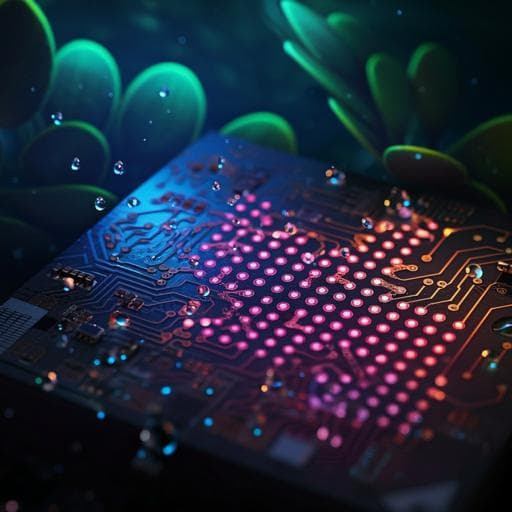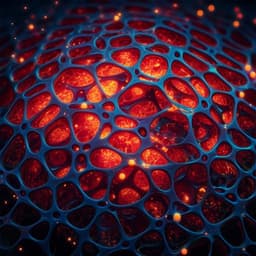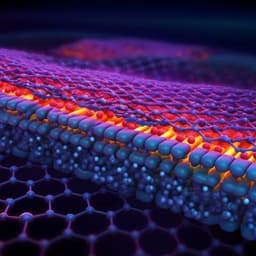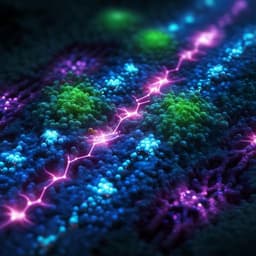
Engineering and Technology
Selective ion sensing with high resolution large area graphene field effect transistor arrays
I. Fakih, O. Durnan, et al.
Discover how a groundbreaking wafer-scale graphene transistor technology, developed by Ibrahim Fakih and colleagues, is revolutionizing real-time ion sensing. This innovative approach enhances the resolution and selectivity of ion-sensitive field-effect transistors, enabling accurate measurements of multiple ionic species in a dynamic environment.
~3 min • Beginner • English
Introduction
The study addresses the challenge of accurately, rapidly, and simultaneously measuring multiple ionic species at low concentrations. Conventional potentiometric ISFET sensors suffer from limited selectivity because ion-selective membranes respond to interfering ions, and silicon-based micro-scale ISFETs face resolution limits due to low-frequency charge fluctuations as device area is reduced. Prior multi-ISFET arrays have struggled to meet the high resolution and detection limits required for real-time sensing. The authors propose that large-area graphene ISFETs, fabricated at wafer scale, can provide high signal-to-noise ratio via large channel area and high carrier mobility, enabling high-resolution potentiometric sensing. By assembling an array of ion-selective graphene ISFETs and applying Nikolskii-Eisenman analysis to correct for cross-sensitivity, the work aims to achieve accurate, real-time, simultaneous quantification of multiple environmentally relevant ions for applications such as water quality monitoring.
Literature Review
The paper reviews solid-state ISFET technologies and alternatives. Silicon CMOS ISFETs have achieved large arrays (up to 10^7) for pH, but scaling reduces resolution due to increased low-frequency noise. Resolution improves with increased channel area, mobility, and gate-to-sensing site capacitance, making large-area arrays in silicon impractical. Alternative materials/architectures include Si nanowires, combined Si FET and BJT, AlGaN/GaN HEMTs, MoS2, InN, and carbon nanotubes, with varied sensitivities and resolutions (summarized in Table 1). Graphene is highlighted as promising due to wafer-scale cm^2 devices with mobilities up to ~7000 cm^2V−1s−1 via CVD and thin-film processes. Early graphene ISFETs had modest performance due to functionalization challenges, but prior work by the authors demonstrated stable, high-resolution H+ and K+ sensing at thermodynamic/quantum limits using metal oxide and ionophore membranes. The Nikolskii-Eisenman theory has been used historically to correct for interferences in ion-selective sensors, and prior arrays leveraged this approach but lacked sufficient resolution for many real-time applications.
Methodology
Device fabrication: A 100 mm CVD graphene monolayer grown on polycrystalline Cu (18 µm) was wet-transferred using PMMA onto 100 mm fused silica wafers coated with 115 nm parylene C to minimize unintentional doping and enhance stability. Ti/Au (20/80 nm) source/drain contacts were deposited via shadow mask. Wafers were diced into 1.1 × 1.1 cm^2 dies and mounted to PCBs with silver epoxy, exposing a 0.8 × 0.5 cm^2 window for solution access. Ionophore membranes (50 µL) were drop-cast through the PCB opening and dried overnight; epoxy encapsulated the device backside.
Ion-selective membranes: Custom PVC/DOS membranes with lipophilic salts were prepared for K+ (potassium ionophore III), Na+ (sodium ionophore X), NH4+ (ammonium ionophore I), and SO4^2− (sulfate ionophore I). Standard compositions: 20–25 mg ionophore, 10 mg lipophilic salt (K-TCPB for cations, TDMAC for anions), 330 mg PVC, 660 mg DOS in 4 mL THF; sonicated overnight. Commercial cocktails were used for Cl−, NO3−, and HPO4^2−. Membranes create an ion-selective interface buffering target ion concentration within the membrane.
Characterization: Raman spectroscopy (532 nm) confirmed monolayer graphene with low defect density (D/G ≈ 0.045). Electrical characterization measured two-point resistance uniformity (mean 277 Ω ± 11.9 Ω). Hall measurements across nine devices showed mean hole density 8.27×10^12 cm−2 (SD 8.5×10^11 cm−2) and Hall mobility 1720 ± 240 cm^2V−1s−1. Ionophore deposition n-doped graphene (stronger electron doping for anion membranes) without significant mobility degradation.
Electrical measurements: ISFET drain-source current Ids was measured versus Ag/AgCl-gated reference potential Vref at Vds = 100 mV. Two operation modes were used: (i) extracting neutrality-point potential Vnp via Vref sweeps to obtain voltage sensitivity (mV/decade), and (ii) fixed Vref current-mode for real-time Ids changes (µA/decade). Temperature dependence (1–60 °C) and pH interference were assessed.
Calibration of selectivity and sensitivity: Using the separate solution method, each ISFET’s response was measured concurrently in solutions containing only one salt at varying concentrations, with a common reference electrode (Vref = −0.2 V, Vds = 0.1 V). Linear fits of Ids vs log concentration for target and interfering ions yielded current sensitivities sii and, via offset analysis, Nikolskii selectivity coefficients Kij. The coefficients were validated using the mixed solution fixed-interference method, comparing detection limits in presence of a background interferent.
Concentration estimation in mixtures: A modified Nikolskii-Eisenman equation in current form was used: Ii = Ii0 + sii log(a_i + Σ_j Kij^(sij/sii) a_j^(sii/sjj)). With calibrated Ii0, sii, and Kij, nonlinear systems for cations and anions (solved separately) were numerically solved to estimate activities (treated as concentrations in the explored range) from simultaneous current readings across the array.
Multi-ion tests: Real-time measurements were performed in DI water initially spiked to set starting concentrations of seven ions, followed by sequential additions of salt mixtures. ISFET currents were recorded concurrently; concentrations were computed at each time point from the calibrated model.
Aquarium experiment: An ISFET array monitored an aquarium containing duckweed (Lemnoideae lemna) daily over three weeks. After one week, nutrients ((NH4)2SO4, K2HPO4, NH4Cl) were added to set initial ion levels. A control without plants was run in parallel. Concentrations were derived from the array currents using the calibrated Nikolskii-Eisenman framework.
Controls to prevent artifacts included strict cleaning, DI water rinsing between measurements, and limiting Vref sweep range to avoid electrolysis and excessive gate current.
Key Findings
- Large-area graphene ISFET array measured K+, Na+, NH4+, NO3−, SO4^2−, HPO4^2−, and Cl− simultaneously in real time, down to ≤10^−5 M.
- Sensitivities (mV/decade via Vnp): NH4+ 58.6; NO3− −56.7 ± 0.2; Na+ 49.2; K+ 45.7; Cl− −43.0 ± 0.2; SO4^2− −22.6; HPO4^2− −34.9 ± 0.2. NH4+ and NO3− approach Nernstian limits at 23 °C; sub-Nernstian responses for Na+, K+, Cl− likely due to ionophore/lipophilic salt ratios; apparent super-Nernstian HPO4^2− response explained by phosphate speciation (~40% H2PO4− at pH 7.5).
- Current-mode sensitivities supported linear detection to ≤10^−5 M; typical rms noise ≈ 30 nA in 60 Hz bandwidth resulted in minimum resolvable changes of approximately: 3×10^−3 log M for cations, 3×10^−3 for SO4^2−, 5×10^−3 for HPO4^2−, and 2×10^−2 for NO3− and Cl−.
- Temperature dependence of sensitivity was linear and consistent with Nernst/Nikolskii-Eisenman predictions; pH interference for cation sensors (Na+, K+, NH4+) was small compared to target ion responses.
- Selectivity coefficients Kij (Tables 2 and 3) quantified cross-sensitivities; e.g., K+ ISFET was the least selective among cations; some anion sensors (SO4^2−, HPO4^2−, Cl−) exhibited higher response to NO3− or HPO4^2− than to their primary targets, revealing membrane limitations. Kij from separate solution and fixed-interference methods agreed within 1% in log units and were consistent in magnitude with literature values for the ionophores used.
- Two-ion mixtures (K+/NH4+, Na+/NH4+): concentrations inferred from simultaneous ISFET currents matched prepared values within ±0.01 log units over >4-decade concentration ratios.
- Seven-ion mixtures: cations were estimated within ±0.01 log units; anions within ±0.05 log units. Nonlinear solver occasionally failed for anions due to lower sensitivity/selectivity of Cl− and NO3− sensors.
- Aquarium study with duckweed: after nutrient addition, concentrations of K+, NH4+, Cl−, HPO4^2−, and SO4^2− decreased by ~70–80% over three weeks, consistent with plant uptake; control without plants showed constant concentrations.
- Overall array accuracy comparable to spectrophotometric/chromatographic techniques; best-case resolution ~2×10^−3 log units (from abstract), while array-level resolvability stated at ~3×10^−2 log M in conclusion for multi-ion operation.
Discussion
The approach directly addresses the central challenge of poor selectivity in potentiometric ion sensing by combining an array of ion-selective graphene ISFETs with Nikolskii-Eisenman analysis to decouple cross-sensitivities. Large-area graphene channels provide high transconductance and low noise, enabling high resolution at practical biases. Calibrated selectivity matrices (Kij) derived via separate solution (and validated by fixed-interference) methods allow accurate inversion of sensor responses to concentrations in complex multi-ion samples. The array achieved ±0.01 log unit accuracy for cations and ±0.05 for anions, approaching established analytical techniques while offering real-time, on-site measurements. Temperature and pH effects were characterized; temperature dependence followed theory and pH interference was minor for cations, though selecting the targeted ion set remains crucial to avoid unmodeled interferences. Instances of failure in solving anion concentrations highlight the importance of sensor sensitivity and selectivity for stable inversion; improving anion membranes or adding redundant sensors could mitigate this. The aquarium experiment demonstrated practical applicability in environmental monitoring, capturing nutrient uptake dynamics in situ over weeks, and a control confirmed specificity of observed trends.
Conclusion
Wafer-scale, large-area graphene ISFET arrays functionalized with ionophore membranes can simultaneously and accurately quantify multiple ions in real time, overcoming selectivity limitations of individual potentiometric sensors via Nikolskii-Eisenman analysis. The devices show linear response down to ≤10^−5 M with high sensitivities, achieving accuracies of ±0.01 (cations) and ±0.05 (anions) log concentration units and best-case resolution ~2×10^−3 log units. The approach was validated in controlled multi-ion solutions and demonstrated in an aquarium environment, tracking nutrient uptake by duckweed over three weeks. Future work could expand the array to cover additional ions of interest, optimize ionophore formulations—particularly for anions—to enhance sensitivity/selectivity, improve membrane deposition uniformity, and develop robust calibration/auto-recalibration protocols to maintain accuracy over time.
Limitations
- Selectivity limitations of some ionophore membranes: e.g., Cl− sensor more sensitive to HPO4^2−; SO4^2− and HPO4^2− sensors showed strong NO3− interference.
- Lower sensitivities and transconductance for certain anion sensors (Cl−, NO3−) led to occasional failures in solving the nonlinear concentration system.
- Sensor performance depends on temperature and, to a lesser extent, pH; environmental variations necessitate compensation.
- Device-to-device variability in membrane-induced doping; improved membrane preparation and deposition could reduce variability.
- Accurate inversion requires that all significant interfering ions be included in the array; missing species can bias estimates.
- Recalibration of selectivity coefficients is required if sensor performance drifts over time.
Related Publications
Explore these studies to deepen your understanding of the subject.







